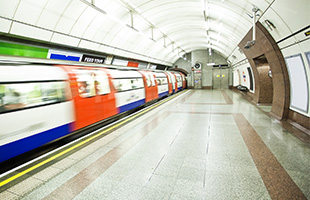Heat generated from the London Underground

Everyone who has travelled on London’s tube will know that it’s often really hot. I am personally not a big fan of crowded places, even more so when they reach up to 35°C degrees in peak hour.
Last year, in the month of July, the temperature recorded was over 35°C 1 between Oxford Circus and Liverpool making public transport quite uncomfortable. However, this did make me question whether we can actually obtain something positive from this?
Around 89% of the heat in the underground is produced by the train system (38% braking losses, 22% mechanical, 16% drivetrain, 13% train auxiliaries, 4% tunnel support systems) and only 7% is produced by passengers. It has been calculated that from all the heat produced, 79% is absorbed by the tunnel walls, 10% is removed by ventilation and the other 11% remains in the tunnels.2 Over the past 100 years the clay surrounding London’s Underground has warmed and is no longer able to absorb the trapped waste heat, which is one of the main contributing factors of the Underground’s high temperatures 3.
According to the United States Department of Energy, the energy waste which ends up in the atmosphere as waste heat could be recovered for facilities to fulfill up to 20% of total electricity demand.4 Waste heat represents the largest area for improvement in energy production. The use of waste recovery heat networks can play an important part for the future of urban areas in helping lower heating bills, reduce carbon emissions and make the capital more self-sufficient in energy. Cities should create operational waste heat-recovery systems to make urban areas as energy efficient as possible.
London is an example of a city that is developing in a more environmentally friendly way. A recent study in London’s Underground has shown that it is possible to collect and recycle energy from the heat generated by utilising new technology systems. The system works by converting energy generated by the trains when they brake, into electricity. When a train brakes, the kinetic energy produced by the motor to stop the train is converted by the generators into electrical energy, which is then transmitted back to the conductor rails to be used by other trains. If, by any chance, there are no trains nearby, the energy is lost and the energy is wasted as a heat. The creation of an inverter system allows the energy to run back from the generators to the electrified rails, and back into the system, providing an alternative path.5 The system will not only create an alternative path of energy, it will reduce the underground cost of using air conditioning to combat the high temperatures, as the structure prevents the train from converting it into heat.
A study trial was put in place over a 5 week period, when a modified inverter system was installed and monitored at Cloudesley Road substation on the Victoria line.5 Based on the results of the trial, the experiment has captured enough energy to power a station as large as Holborn for more than two days per week. The results show that the new technology could reduce its overall carbon footprint and save as much as £6m every year for reinvestment in improving transport.6
In response to these findings, London plans to reduce carbon dioxide emissions by improving waste heating systems.
The city is part of a project called Celsius, which aims to demonstrate how the efficiency and performance of district heating systems can be improved by capturing and utilising sources of waste heat that are generated within cities. The project is a partnership between Islington Council, UK Power Networks and Transport for London and will capture waste heat from London Underground tunnels and an electrical substation to help warm homes and cut energy bills. 7
Sadiq Khan, mayor of London, has published his plans of expand the Bunhill Energy Centre in Islington. The phase 1 of this centre was created in 2012 and heats two leisure centres, three-communally heated council housing estates and one private housing development, covering 850 units in total.8 Recently, the Council, Bunhill Ward and the CELSIUS research project agreed to fund an extension of the heat network, from Bunhill Energy Centre up Central Street to City Road to capture heat from the tube network, which will connect a further 454 homes in the area, with the potential to supply a further 1,000 homes.9
London is a perfect example that there are many opportunities to become a more environmentally friendly city. If the future is living in metropolitan areas, we should pay attention to how we build cities which respect the environment and make it a better place to live in.
References
- How Hot Does It Get On London’s Public Transport? Article by Rachel Holdsworth. Available at: http://londonist.com/2015/07/itd-be-illegal-to-transport-cattle-in-these-temperatures,
- Cooling the tube Rail Engineering, November/December 2007. Available at: http://www.plantengineer.org.uk/article-images/23757%5Ccooling.pdf
- Thies, N. (2015) London Calling to the Underground: Waste Heat in Urban Morphology is Going Down the Tube. Available at: http://digitalcommons.wcl.american.edu/cgi/viewcontent.cgi?article=1565&context=sdlp
- Waste Heat Recovery. Available at: http://coolenergy.com/waste-heat-recovery/
- Tube innovation: recycling waste energy. Article by Gary Peters Available at: http://www.railway-technology.com/features/featuretube-innovation-recycling-waste-energy-4785434/
- Recycling energy from Tube trains to power stations. Available at: https://tfl.gov.uk/info-for/media/press-releases/2015/september/recycling-energy-from-tube-trains-to-power-stations
- Waste heat from the Tube will help to warm hundreds of homes. https://www.london.gov.uk/press-releases-5910
- Sadiq Khan unveils plan for London clean energy revolution. Available at: http://www.sadiq.london/sadiq_khan_unveils_plan_for_london_clean_energy_revolution.
- Cheaper, greener energy in Islington. Available at: http://www.islington.gov.uk/services/parks-environment/sustainability/energy-services/Pages/bunhill-heat-power.aspx
Date:
Nov 17, 2016
Author:
Cristina Ortega

